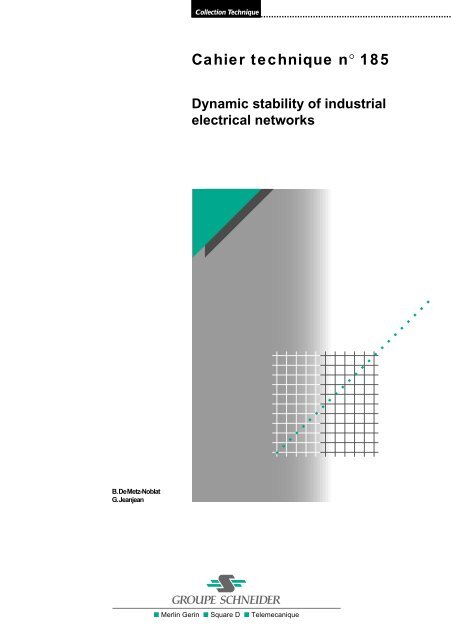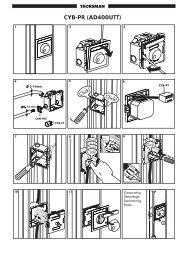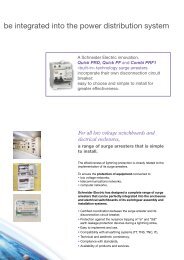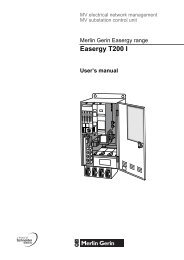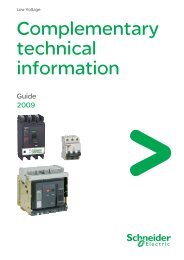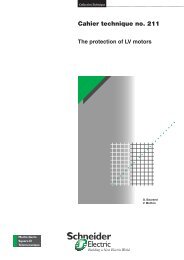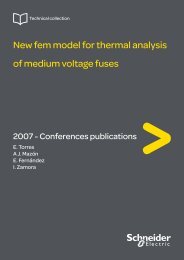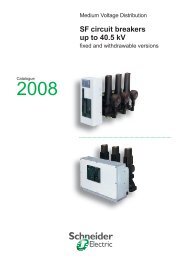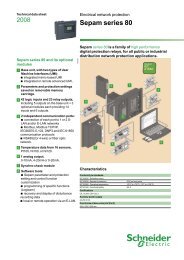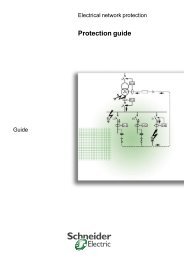Download - Schneider Electric
Download - Schneider Electric
Download - Schneider Electric
Create successful ePaper yourself
Turn your PDF publications into a flip-book with our unique Google optimized e-Paper software.
n° 185Dynamic stability of industrialelectrical networksBenoît de METZ-NOBLATESE engineer, after a period with the Groupe Saint-Gobain he joinedMerlin Gerin in 1986. He is currently in charge of the <strong>Electric</strong>al SystemAnalysis Department, responsible for studying electrical phenomenaconcerning network operation and interaction with equipment anddevices.Gérard JEANJEANEngineer with MERLIN GERIN since 1980, he joined the <strong>Electric</strong>alSystem Analysis Department in 1984 to work on industrial networkstudies with special emphasis on dynamic stability studies. Hespecialises in disturbances and dependability of electrical networks.E/CT 185 first issued june 1997CT 185 / pp.1
a - AmplitudeTensionVoltagedipVoltagesagVoltagelossSustainedover-voltageOvervoltage1.1 U nU n0.9 U n0b - DurationSubtransients Transients Short Long0 0.1 sfig. 1: voltage disturbances in networks.1 s 1 min Time1.3 Stability of networksNetwork stability is characterised by thefluctuations in the powers flowing in the networkand is measured by the variations in time of theassociated voltages and frequencies.A distinction must be made between:c Stability in steady state: the network has astable behaviour, i.e., when subjected to smalldisturbances it returns to its initial point ofoperation with, possibily, damped oscillationsuntil balance is restored.c Stability in transient state: on moving from onesteady stable state to another as a result of avoluntary or accidental durable disturbance, thechange in balance is accompanied by a dampedoscillating variable state considered to beacceptable with respect to the predefined limitsof ∆U, ∆f, ∆t.c Instability in the transient state is observedwhen, further to a serious disturbance, theoscillating state is divergent. Either a lossof power supply or a new unacceptablestable state is induced (e.g. a « crawling »motor).c Stability in dynamic state: the network is able toavoid all divergent oscillating states and to returnto an acceptable stable state. This includestripping of protection and automatic devicesaccording to the disturbance under consideration.The dynamic stability studies consist of:c considering the main critical scenarios such asshort-circuit, loss of mechanical power, loss ofelectrical supply, load fluctuations, processconstraints,c predicting network reactions to thesedisturbances,c recommending the appropriate operatingmeasures such as type of protection device,relay setting, load shedding, configurations…in order to avoid undesirable operating modes.Such studies therefore enable the reactions ofthe network considered (publicor private, HVor LV) to be mastered.CT 185 / pp.5
1.4 Industrial networksAt this point we shall mention a few characteristicsspecific to industrial electrical networks:c geographical size of sites of up to severaldozen hectares,c length of connections, lines and cables, of up toseveral kilometers for the various voltage levels,c energy sources: external electricity boards,autonomous energy production (isolatednetwork) and mixed solutions,c voltages: several levels in a range varyingfrom 380 V to 90 kV or more,c powers: 250 kVA to 100 MVA or more,c loads: dominated by the presence ofasynchronous motors. Also note specialloads linked to the process (e.g. electrolysis,furnaces…),c complexity of the network architecture whichmust be able to supply priority loads, possesssupply backup sources and have reconfigurationabilities,c stability time constants: normally one to tenseconds.2 Behaviour of an industrial electrical networkThe behaviour of an electrical network duringtransient phenomena depends on the behaviourof each of its components.These components, starting from a stable state,will affect the transient behaviour of the networkas a whole. When the disturbance has passed,they will either be in the same stable state asbefore the disturbance, in another stable state orin an unstable state which normally results inloss of one or more components due to trippingof the protection devices. Knowledge of thebehaviour of each component is thus vital indetermining the overall behaviour of theelectrical network under consideration.2.1 Passive loadsThese are loads such as lighting andheating, whose electrical variation rules areof the type:α⎡P = V ⎤⎡ V ⎤⎢ ⎥ P n and Q = ⎢ ⎥ Q n⎣V n ⎦⎣V n ⎦where α and β are load characteristics.β2.2 « Power electronic » loadsA large number of loads: electrolysis tanks,variable speed drive, heating using a.c. voltagecontroller, etc. belong to this load category.The common feature shared by these loads istheir great sensitivity to voltage variations.For example a variable speed drive may bestopped completely for a voltage variation ofaround + 15%. Added to this is a certainpotential sensitivity to frequency variations,making these devices part of those loadsaffected by the stability problems of electricalquantities.The same applies to computer equipment.2.3 Transformers and connectionsTransformers, lines and cables used to conveyelectrical energy between sources and loads, arecharacterised by their impedances which createvoltage drops and active energy losses accordingto the current flowing through them. Theirimportance is decisive in the transient state:c strong inrush currents cause voltage dropswhich can be critical,c the impedance that they induce betweensynchronous sources (known as « electricaldistance ») may be the cause of long-lastingoscillations.CT 185 / pp.6
deceleration of the motor (see fig. 4 ). Themotor, as it slows down, can restart without riskwhen voltage is restored provided that thevoltage U reaccel remains within acceptable limits.When θ = 180°, U reaccel is at its greatest value,i.e. nearly twice network voltage. The consequencesare destructive torques, and currents(15 to 20 I n ) far greater than starting currents.Points to note:c The importance of rotating mass inertia -motor plus driven machine- characterised by itsinertia constant, H, which expresses thesensitivity of the speed of the machine tovariations in voltage or load:rated rotating kinetic energyH =rated apparent electrical powerc The effect of the mechanical load torquecharacteristic as a function of the speed of thevarious rotating loads.Decelerationθt = 0.5 sNetwork voltaget = 0fig. 4: residual voltage and « reacceleration » of anasynchronous motor network voltage.c In motor transient behaviour, its operatingconditions depend on the various characteristictime constants of the motor.δSelf-inducedresidualvoltage∆U reaccel2.5 Synchronous machinesSynchronous machines are a common feature inindustrial networks. They may be installed for anumber of reasons:c recovering energy from an exothermal orcogeneration process,c need for a complementary source of electricityfor:v an « EJP » contract: specific EDF contractencouraging consumers to limit their energyconsumption at peak times.v standby source,v peaks,c reactive energy compensation.These machines play a vital role in networkstability phenomena. A brief reminder is providedbelow.Static stabilityA synchronous machine can be represented bythe diagram in figure 5a where:c R: stator resistance,c X: synchronous stator reactance,c E: stator e.m.f. created by the rotor excitingwinding,c U: voltage at the terminals of the on-loadstator.The corresponding vector chart is given infigure 5b: the internal angle, δ, of the machineis defined as the angle between the vectors U →→and E. This angle is equal to the angle by whichthe rotor is offset with respect to its no-loadoperating position (if I = 0, δ = 0).By ignoring R, a quick calculation shows that theactive electrical power transmitted to the networkis calculated by: P= E U sine δXa - Diagram of a synchronous machineϕEIMachineR ; Xb - Vector chart for the above machineIδNetworkfig. 5: representation of a synchronous machine.It is obvious that the electrical power transmittedto the network is limited to the value of E UXa value which is reached for δ = 90°.P can be represented as a function of δ (seefig. 6 ). In this diagram the mechanical power P mURIUEjXICT 185 / pp.8
PP mA B090° 180°fig. 6: power generated by a generator as a function ofthe internal angle.δimmediate, and inertia continues the move topoint D. From this point, deceleration to point Cfinally stabilises the phenomenon, after a fewoscillations.Energy calculations show that the position ofpoint E is defined by the criterion area: areasABC and CDE are equal. Consequently, themaximum internal angle, δmax, can be greaterthan 90° in transient manner. The dynamicstability limit is thus higher than the static stabilitylimit.However the difference between P1 and P2 mayat times be so great that the criterion areasceases to apply (see fig. 8 ).Psupplied by the driving machine (turbine or dieselfor example) is represented by a horizontalstraight line. The operating point is given by theintersection of this horizontal line with the sinewave. In point of fact, two operating points, Aand B, are possible. Starting from A if, for anyreason, the angle δ increases, the powertransmitted to the network will increase and themachine will slow down. This causes δ todecrease, the starting point is resumed andoperation is stable. An identical reasoning showsthat point B is unstable, just like all points on therectilinear part of the curve.If we no longer assume that R = 0, the limitfor δ is an angle ψ such that tgψ =– X RThe static stability of a generator (i.e. its ability tocope with a slow variation in load) can bedefined according to two complementarypractical considerations:c operation is stable only if the internal angle δremains less than a limit angle close to 90°,c the active power transmitted to the network islimited. It is at its greatest when the stability limitis reached.Dynamic stabilityDynamic stability problems result from themachine moving from one stable state toanother. Let us consider the example of asudden power variation on the turbine whichmoves abruptly from a supplied power P1 to asupplied power P2 (see fig. 7 ).The slow increase in power from P1 to P2 wouldcause a gradual shift from point A to point Cwhile remaining on the curve. However thesudden application of this power increment is notpossible, as mechanical inertia makes itimpossible to suddenly move from an angle δ1to an angle δ2. This explains the instantaneousmove from point A to point B.The angle δ then increases from δ1 to δ2.However on reaching point C, stabilisation is notP2P10PP2P10B C XAδ1ABδ1Cδ2δ2Eδ3D90°180°fig. 7: displacement of the generator operating pointfurther to an increase in mechanical power.There is no point D corresponding to the law ofareas. The generator accelerates from point B topoint C, then up to point X: at this point itcontinues to accelerate while remaining on thecurve, and the power transmitted to the networkdecreases. If the network is supplied by othersources, loss of synchronism occurs due tooverspeed.90° 180°fig. 8: instability (overspeed) further to a mechanicalpower step.δδCT 185 / pp.9
Two important observations must be made at which shows that for a given variation in drawnthis point:power, modification of the electrical anglec the risks of dynamic stability losses are linked decreases with the angle.to sudden major changes in network or turbineNote that in reality, in transient state, thestate,transient and subtransient reactances of thec the risks of dynamic stability losses increase machines, taking account of time variations inas the power supplied by the synchronous flux, must be considered in addition to X.machine reaches the static stability limit.These facts are expressed by the notion of However speed and voltage controls play asynchronising power P S= dPdδ = EU crucial role in enhancing the reactions of the setX cos δ to the network.2.6 The regulationsThe purpose of the regulations is to ensurecorrect operation:v stability of voltage amplitude,v stability of network frequency during variationsin load or driving power,v sharing of active and reactive electricalpowers.c Frequency/active power regulation.v Take the simple case of a generator, the onlyload source, equipped with a speed regulator.Network frequency, proportional to generatorrotation speed, is set by the primary speedadjustment of the mechanical drive deviceadapting the power to be supplied. The resultingautomatic regulation is defined by its droopcharacteristic which expresses the totalfrequency deviation for the complete powerrange (see fig. 9 ).Frequencyf maxf nominalef minf0P1area of secondaryadjustment effectprimary adjustmentdroop characteristicP ratedP maxfig. 9: generator droop characteristic and effect ofsecondary adjustment area of secondary adjustmenteffect.PfAlt.1P1P2Alt.2Powerfig. 10: coupled generators - power distribution as afunction of droop.As we move away from the operating point(P n , f n ), any increase in active power supplycauses a drop in frequency and vice versa.Thus, for example, a 4% droop guarantees afrequency of 49 to 51 Hz (50 Hz x 4% = 2 Hz).To remove this error, a compensation can beintroduced which moves the droop characteristicparallel to itself as a function of speed thanks toa secondary adjustment.In dynamic state, the system time constantsvary from a few hundred ms to a few seconds.A corrector (Integral, Derivative, lead/lagmodules) are used to partially relieve theinevitable consequences of this relativeslowness.v When two generators are coupled, theiroperating point depends on their droop and theirpower (see fig. 10 ).CT 185 / pp.10
Any power variation is accompanied by afrequency variation, and the sharing of powerbetween the generators is in proportion to theirrespective droop. It is thus possible to imagine awhole host of different operating configurations.v The case of coupling a generator to a networkis an extension of the above case where thenetwork has a virtually almost zero droop. In otherwords, frequency is imposed on the generator,and its regulation is then a power regulation.v In short, the action of the electromechanicalregulator of the generator’s driving machine isused to adjust network frequency and/or theactive power transmitted.c Voltage/reactive power regulation.If the above logic is transposed to the useof a generator excitation regulator, we observethat network voltage amplitude and/orreactive power transmission can be adjustedin order to solve the problem of the naturalcharacteristic (U = f(I) at constant excitation)of the generator and the problem of loadfluctuations.2.7 The electricity board’s networkThe electricity board normally delivers a specificvoltage, guaranteed by contract in a certainamplitude and frequency range.For example the EN 50160 standard whichcharacterises the quality of the voltage suppliedby public networks, stipulates the variationsaccepted for frequency and voltage (see fig. 11 ).The electricity board gives the short-circuit powerof the source at the point of common coupling(normally three values: high, low and medium,allowing for the configuration of its network).Faults present on the electricity board’snetwork are passed on to the customer:their characteristics and frequency are random,and the protection plan installed may result instandard supply breaking times.LV/MV networkOne week 95% periodOne week 100% periodSynchronous connectedto interconnected systemNot connected to interconnectedsystem50 Hz ± 1%95% of rms U n (10 minutes) ± 10%50 Hz ± 2%95% of rms U n (10 minutes) ± 10%50 Hz ± 4% ; – 6%95% of rms U n (10 minutes) ± 10%50 Hz ± 15%95% of rms U n (10 minutes) ± 10%fig. 11: accepted variations for frequency and voltage in public networks (as in EN 50160 standard).2.8 The protection devicesThe purpose of these devices is to protectpersons and equipment. They are mainly usedwhen an abnormal transient phenomenon occurs.The following disturbances are at the origin oftransient phenomena:c electrical faults occuring on the electricityboard’s network,c internal electrical faults,c supply and consumption transfer operations(manual or automatic),c startup and reacceleration of large motors orproduction units,c loss of part of production (tripping of agenerator set, transformer or line).The protection devices are designed to removefaulty parts selectively and rapidly and to ensure,insofar as possible, supply of priority and vitalprocess loads.The main protection devices are:c overcurrent protections, which can be:v constant/reverse time, instantaneous/timedelayed,v directional.c Undervoltage protections,c more specific protection devices such asfrequency drop, overspeed, reverse power,residual current, under impedance…These protection devices are backed up byautomatic devices such as source changeoverswitches, load shedders/restorers which havethe effect of attenuating or of generating powertransients on the network.The action of both the protection devices and theautomatic devices is decisive in treating dynamicinstability.CT 185 / pp.11
2.9 The network as a wholeOverall network behaviour is the result of theindividual behaviour of each of its components,including protection and monitoring/controlequipment, and of their interactions.c Static stability defines the power flows in thenetwork for all normal operating modes of theindustrial site (configuration of the network andproductions in progress). In each case the« voltage operating schedule » specifies theactions to be performed to keep voltage withinacceptable limits (e.g. better than 3%) and tominimise losses for:v power delivered by the sources,v adjustment of transformer taps,v compensation capacitors.c Dynamic stability constraints condition networkevolution according to operating modes andincidents, as well as the actions to be taken tominimise risks and disturbances to the process.Note that monitoring and control plays animportant role in both normal and abnormaloperation of the network in that it providesknowledge at all times of generator power flows,voltage and load.At this level the complexity of the global problemis far greater than that of a « static » state.Dynamic stability studies are then used torecommend the most appropriate measures tobe taken and solutions to be implemented foreach individual case.3 Dynamic stability study of industrial networksThe purpose of this chapter is to provide generalinformation on the objectives assigned to thestudies and on the study content, with particularemphasis on the causes, effects and solutions ofdynamic instabilities. Finally a study conductedby the « <strong>Electric</strong>al System Analysis »Department will be presented as an example.3.1 GeneralStudy objectivesDynamic stability studies consist of analysingand acquiring prior knowledge of the variations intime of electrical quantities at various points of anetwork, and of the changes in the mechanicalparameters of rotating machines as a result ofsudden disturbances.The purpose of these studies is to find:c the network operating conditions able toensure proper continuity of load supply,c the maximum available power when adisturbance occurs,c the optimum adjustment values of theprotection system components,c the load shedding plan to ensure supply ofvital loads,c the best machine regulation adjustments.Each study is based on a specific casedepending on:c types of sources,c types of loads,c network architecture,c network operating mode,c the instability causes taken into account.There are various reasons for studying dynamicstability:c preventive study when designing a network,c addition of high power generators and/orloads on an existing network,c curative study when an incident occurs.If the study is conducted before the installation isproduced, these factors can be modified for themost part. Operators can thus be certain that intransient modes, the behaviour of the networkCT 185 / pp.12
and machines will match expectations andrequirements.Studies can either be global or limited to aprecise problem, for example in the case ofcoupled operation between an EDF network anda generator: determining the exchanged energylimit ensuring in the event of decoupling that anunstable operating point of the priority network isnot reached (see fig. 12 ).Non-priorityfeedersPublic distributionnetworkCouplingGMPriorityfeedersfig. 12: double source network with priority feeders.Causes of instabilityc <strong>Electric</strong>al phenomena.The disturbing phenomena affecting networkstability are those which cause variations inactive/reactive power:v variation in source characteristics:- short-circuit power,- voltage sags and drops,- short or long power cuts,- frequency variation (isolated network).v Variation in network load, for example:- at rated load, generators have a lowsynchronising power,- off -load a network can become capacitive.v <strong>Electric</strong>al faults, the most noteworthy of whichis the full three-phase short-circuit.c Network composition and operating mode.The many parameters involved in networkoperation offer a whole host of configurations,some of which favour risky situations:v the machine interconnection mode andcoupling to the electricity board’s network, aswell as the priority and non-priority busbars,v the rated operating point of generators, onwhich the available power margin and thesynchronising power depend,v the regulation mode of synchronousmachines: speed or active power regulation,voltage or reactive power regulation,v coupled impedances (e.g. parallel-connectedtransformers),v the protection plan: types of protections andadjustments, coupling/decoupling logic, loadshedding/restoration,v the characteristics of motor torques and drivenmachine load torques (see appendix 1).c Process operation.In the case of backpressure turbo-generators,process fluctuations cause variations in steamconsumption and thus variations in themechanical power supplied by the turbine. Thesefluctuations can generate unstable operatingstates of the electrical network due to theresulting power fluctuations and oscillations.Fluctuating loads, such as resistance furnacesregulated by a.c. voltage controllers, by theirvery nature cause power variations.Piston compressors have a load torquecomparable in absolute value to the one suppliedby diesel motors. The resulting speedoscillations have a high probability of enteringinto resonance with a natural frequency of theregulation system and of causing stability losses.This phenomenon is likely whenever the loadsupplied by the network varies rapidly, forexample in tack welding workshops.Effects of instabilityc On rotating machines.During transients, the power exchanged betweenmachines and between machines and thenetwork generate sudden variations in torque.The resulting mechanical stresses may give riseto mechanical failures (shaft breaking).The frequency and voltage of generators stressedbeyond their capacity drop, and their voltage andspeed regulations may enter into resonance witha disturbance and amplify the instability effects.Motors subjected to frequency oscillations andvoltage drops slow down. When the disturbanceshave been eliminated, the high current absorbedand marked voltage drops can makereacceleration a problem: some motors crawl oreven stall accompanied by abnormal temperaturerises, and the network finds it harder to return tostable operation except in the case of rapid loadshedding of some large units.CT 185 / pp.13
c On the network.The power oscillations responsible for very highcurrents in the connections and transformerscause temperature rises which seriously affectequipment withstand.Voltage drops resulting from the high currents,cause malfunctioning of certain sensitivedevices (e.g. contactors, electronicequipment…). Disconnection of one or moregenerators destroys the consumption/productionbalance and may cause total collapse of thenetwork.Mastering instabilityA number of measures can be taken to preventthe instability limit from being crossed:when these measures are taken at generator,network or load level, they either preventinstability or help fight against it effectively rightfrom the start.c At generator level:The use of generator sets with very highmechanical inertia reduces the effect of loadvariations.The adjustment parameters of the variousregulations give response speed choices wellsuited to the disturbances considered.Choice of generator operating point is important:power margin available on request,synchronising power potential.c At network level.v All measures tending to decrease impedancesof tie lines increase the chances of returning to astable state after an incident,v redundancy of sources and the possibility ofshedding non-priority loads, minimises theduration and depth of voltage sags. Loadshedding/restoration by power step preventsmajor disturbances.v Rapid, selective elimination of the shortcircuitedpart of the network limits harmfulconsequences for the network (rapid-action,limiting circuit-breakers).v The protection plan must take account ofthe various instability scenarios (choice andadjustment of protection devices, use of logicdiscrimination instead of time discrimination).v Tripping by separate phase in order toeliminate single-phase faults in transmissionnetworks, and use of shunt circuit-breakersfor MV distribution networks, have beneficialeffects on factory network stability.c At load level.v Use of « starters » to attenuate the motorenergising current,v implementation of undervoltage anddirectional protection devices and transitmonitoring of powers for large motors,v monitoring loads with cyclic or intermittentoperation.3.2 Stability studiesPositioning the problemWe remind you that the dynamic stability of anetwork is the capacity of this network to resumenormal operation after a sudden disturbance.A stability study thus consists of analysing theelectrical and mechanical behaviour of machinesfrom the time when the disturbance appears tothe time when, the disturbance having beeneliminated, the network returns or fails to returnto normal operating conditions. The problem is athree-fold one:c <strong>Electric</strong>al: involving the standard networkequations (Kirchoff’s laws) where the machinesare represented by Park’s equations enablingtheir transient states to be studied.c Dynamic of the variations around a state ofequilibrium involving the speed and excitationregulation transfer functions.c Mechanical as we need to know whether ornot machine speed is maintained; themechanical equations of each machinedωJ = C m –C r take account of the momentdtof inertia J and the characteristics of load andmotor torque.Calculation methods usedc Analytical method.In simple network cases, i.e. networks containingonly one machine (possibly two) and passiveloads, the analytical description of machineparameter evolution if a fault occurs is feasible.This analysis is possible in cases where speedcan be considered constant. The machineequations describe their behaviour in sufficientdetail even if some parameters are overlooked.CT 185 / pp.14
The various methods of analysis (Behn-Eschengurg, Potier’s diagram, Blondel’sdiagram) enable knowledge of the efficiency,excitation current and voltage drops ofgenerators and motors. Park’s transformationapplied to machines enables both steady andtransient states to be analysed.c Digital simulation.This method is the one universally used today.A computer digitally solves the equationsystems describing network behaviour. Theincreasing power of microcomputers nowenables large networks to be simulated inreasonable times and fine analyses of thebehaviour of machines and network componentsto be considered. As all loads and generatorscontribute to operation of the whole and interactwith one another, the problem is a large-scaleone and if we are to remain within a rangecompatible with microcomputer capacity, datamust be simplified so as to represent only a fewdozen machines:v by grouping passive loads,v by grouping motors as « equivalent motors »with identical behaviour,v by grouping generators in the same way,v by comparing a very powerful source withrespect to the powers studied, with a perfectsource in series with an impedance.These calculation preliminaries are obviouslyvital as they define the assumptions which mustbe reasonably complex and representative ofreality.The resolution method chosen is a stepwise onetaking account of:v slowly varying quantities: motor torque,relative rotor speed, inductor winding flux,excitation voltage,v rapidly varying quantities: currents andvoltages in the various network branches and thevarious machine circuits, voltage at the machineterminals and power delivered.This method is implemented by a softwaredesigned to treat all types of industrial networks,such as for example the MG-STAB calculationcode developed by <strong>Schneider</strong>.Developing a studyA stability study follows a certain logic and isbroken down into a number of steps describedbriefly below:c The calculation preliminaries.As result accuracy is directly linked to theexactitude of network data, the study begins bycollecting these data and thus looks for the exactnumerical values of the network componentcharacteristics.Modelling then consists of quantitativelydescribing the physical laws governing operationand interconnection of network components inthe form of a data file.Calculation of the initial state of load flows isdetermined by the computer whose specificstability programme processes the data file:voltages at nodes, currents and powers inbranches, sources and loads, machine operatingpoints.c The simulations.Network topology and components vary fromone study to another. Types of disturbances arenumerous and the point of application variable.In the light of the diagram studied, the specialistwill select the disturbances and their applicationpoint according to how critical the problem is.The points considered are normally undervoltageon the electricity board’s network, short-circuits(medium voltage, sources), partial supply losses(lines, transformers, generators), starting of largemotors and effects on electrical energy ofimportant process phenomena.Calculations of dynamic state in time, allowingfor the disturbances considered, reproduce theexpected real reactions of the network and theactions to be taken. The various scenarios areplayed through in order to treat all the chosencases and sensitivity to parameters.c The results.Results are given mainly by curves changing intime: voltages on the various busbars, currentsin feeders, power flows, machine data (speed,electrical and mechanical torque, excitation),regulation of excitations and mechanical drivedevices.In short the results concern operation of theelectrical system in disturbed operatingconditions and enable:v verification of stability,v knowledge of potential backup capacity on afault,v confirmation of the protection plan,v adjustment of the regulations.CT 185 / pp.15
3.3 Study exampleThe case described below is taken from a realstudy of a standard heavy industry industrialnetwork. The aim is to study the impact of ashort-circuit at the secondary of a 63/20 kVtransformer (see fig. 13 ).Description of the networkThe network contains (see fig. 14 ):c A 63 kV EDF source delivering on the 20 kVbusbar of the factory through 63/20 kVtransformers.c An autonomous source made up of twocouplable generators delivering on the 20 kVthrough 3.2/20 kV transformers.c Asynchronous motors supplied in 5.5 kVthrough 20/5.5 kV transformers connected onthe 20 kV network, on priority or non-prioritybusbars: some of these motors are equivalentmachines.c An equivalent passive load representing allthe other factory loads on the priority busbar.The protection devices considered in thisexample are overcurrent, directional ones,applied to the network transformers.Objective of the studyv Study assumption:A full three-phase short-circuit occurs on thesecondary of one of the two EDF 63/20 kVsupply transformers (see fig. 13 ).v Undesirable event:The fault must not cause the loss of the 5.5 MWmotors.v Question to be solved:What is the maximum acceptable faultelimination time if dynamic instability is to beavoided?The qualitative description of phenomena, for thescenario considered, is as follows:c When the fault occurs, voltage at the shortcircuitpoint and on the entire 20 kV commonbusbar is zero (negligible coupled impedances).The power supplied by the generator sets movesfrom the initial value to a very low value due tolosses in the step-up transformers: loadshedding decrease of active power results inacceleration of the generators which continue tobe driven by the turbines whose mechanicalregulations do not immediately react. At thesame time the voltage regulation will raiseexcitation current to its maximum value to try tocompensate the undervoltage.The motors deliver in the short-circuit in the firstphase of the transient state until the flux dies out.Then absence of motor torque, due to very lowvoltage, causes a deceleration.F ➙ OS. C.F ➙ OEDFnon-priorityfig. 13: studied configuration.G1priorityG2The electricity board’s network supplies a currentcorresponding to its short-circuit power in serieswith the parallel-connected transformers.c The overcurrent directional protection deviceswill eliminate the only faulty transformer.c On elimination of the fault, voltage is restoredat the 20 kV busbar. Its value depends on thecombined action of the EDF network, themaximum overexcitation generators and the loadcurrent inrush. The generators are no longereither in phase with one another or with thenetwork (in fact each source has evolvedseparately from the others as voltage wasvirtually zero) and their speeds are different. Thepower they supply is low as turbine energysupply has been reduced by the regulators andthey will slow down. The motors have sloweddown, the rotor field is shifted with respect to thestator field produced by the network, and theirspeeds are different. The inrush current is of theorder of magnitude of the starting current, a factwhich causes serious voltage drops in theconnections as all motors try to reaccelerate atthe same time.c Oscillating energy exchanges then take placebetween the various machines via the networkconnections and transformers. If the generatorspeed deviations, which are at the origin of thesetransient phenomena, decrease, normaloperating conditions are resumed. Otherwise thesynchronous machines fail to recover theirsynchronism and fall out of step. Theasynchronous motors stall or crawl.CT 185 / pp.16
The behaviour study for this network thusrequires complex calculations to ensure return toa stable operating state and knowledge ofvariations in electrical and mechanical quantities.Quantitative studyThe simulation takes place as follows: once thesteady state has been calculated for 0.1 second(thus ensuring good model behaviour), theshort-circuit is simulated at the secondary ofthe 60/20 kV transformer, then eliminated bysimultaneously opening the upstream anddownstream circuit-breakers. The calculation isthen continued for 5 seconds, which is sufficientto analyse network lifetime. Two assumptionsare made concerning protection device trippingtime: 300 and 350 ms, values close to theacceptable target limit.NB: to simplify the example, only the upstreamand downstream protection devices of the twoEDF incoming transformers are considered.We shall now look at the simulation results forone of the 12.5 MVA generators (the generatorsare identical), followed by the behaviour of oneof the 5.5 MVA motors.EDF line63 kV1500 MVAG1G23.2 kV12.5 MVA12.5 MVAEDFtransfo63/2010 MVA10 MVAtransfo3.2/2012.5 MVA 12.5 MVAtransfo20/5.5T51T52 T53 T54 T55 T56 T57 T586.3 MVAUcc 8%6.3 MVAUcc 8%6.3 MVAUcc 10%6.3 MVAUcc 8%7 MVAUcc 8%0.284 MVAUcc 4%0.284 MVAUcc 4%6.3 MVAUcc 8%5.5 kVInertia(kg/m 2 )Loadtorquecoef.M51 M52 M53 M54 M55 M56 M571402280214021402222020CHA584 MW2 MVAR5.5 MVA motors250 kVA motorspassiveloadfig. 14: diagram of the studied installation.CT 185 / pp.17
c Generator.v Examination of active power (see fig. 15 )As soon as the fault appears, the active powersupplied by the generator decreases markedlyand continues to decrease throughout theduration of the fault.Once the fault has been eliminated, an activepower oscillation occurs which is the result of theexchanges between this generator, the othergenerator and the EDF source. This powerexchange corresponds to the power required torestore synchronism between generator andnetwork voltage. If the protection devices tripwithin 300 ms (the fault is removed 40 ms later),the power oscillations quickly decrease andsettle at the initial value. In the second case,however, the oscillations continue withoutshowing any sign of decreasing, and thegenerator is unable to resynchronise.v Examination of reactive power (see fig. 16 ).When the fault appears, the reactive powerincreases markedly and is maintained at a higha - Tripping of protection devices in 300 msa - Tripping of protection devices in 300 msMWMVAfaultfault202010015105-100-200sec1 2 3 4 5 6-5-100sec1 2 3 4 5 6b - Tripping of protection devices in 350 msb - Tripping of protection devices in 350 msMWfaultMVAfault202010015105-100-200sec1 2 3 4 5 6-5-100sec1 2 3 4 5 6fig. 15: variations in active power of one ofthe 12.5 MVA generators.fig. 16: evolution of reactive power of one ofthe 12.5 MVA generators.CT 185 / pp.18
value throughout the duration of the fault. Thereactive power which had settled at roughly2.7 times the value before the fault, continues toincrease after elimination of the fault due to thereturn to a value close to normal voltage value.The reactive power peak corresponds to themagnetisation needs of the network loads.v Examination of speed (see fig. 17 ).Speed increases when a short-circuit occurs asa consequence of the power load sheddingobserved (low U!).Elimination of the fault causes deceleration ofthe generator, and its speed begins to oscillate.If the protection devices trip only after 350 ms(see fig. 17b ), the generator is unable toresume a stable operating state.v Examination of voltage (see fig. 18 ). If theprotection devices trip after 300 ms (see fig. 18a ),voltage is quickly restored to rated value afterelimination of the fault. However, voltage is notrestored and even tends to drop if the protectiondevices trip only after 350 ms (see fig. 18b ).a - Tripping of protection devices in 300 msa - Tripping of protection devices in 300 msΩ—Ω 0faultVfault1.053000120000.95sec1000sec01 2 3 4 5 601 2 3 4 5 6b - Tripping of protection devices in 350 msb - Tripping of protection devices in 350 msΩ—faultVfault1.05300012000Ω 000.95sec1000sec1 2 3 4 5 601 2 3 4 5 6fig. 17: evolution of speed of one of the 12.5 MVAgenerators.fig. 18: evolution of voltage at the terminals of one ofthe generators.CT 185 / pp.19
v Evolution of current (see fig. 19 ).In the same manner as voltage, if the protectiondevices trip after 300 ms, current returns to theinitial value (see fig. 19a ). However it remains ata high average value if the devices trip only after350 ms (see fig. 19b ).The generator protection devices mustdisconnect the generator in the event of trippingafter 350 ms, which does not allow correctoperation of the installation.c Behaviour of a representative motor (see fig. 20 ).Behaviour of motors during two calculations(tripping of protection devices after 300 ms or350 ms) is also representative of the instabilityobserved when tripping time is too long. Whenthis time is 350 ms, the speed of the motora - Tripping of protection devices in 300 msAfault8000600040002000a - Tripping of protection devices in 300 msΩ—Ω 0fault10.950.900.850sec1 2 3 4 5 60.800sec1 2 3 4 5 6b - Tripping of protection devices in 350 msAfault8000600040002000b - Tripping of protection devices in 350 msΩ—Ω 010.950.900.85fault0sec1 2 3 4 5 60.800sec1 2 3 4 5 6fig. 19: evolution of the current delivered by one of thegenerators.fig. 20: evolution of motorspeed.CT 185 / pp.20
studied continues to decrease despiteelimination of the fault (see fig. 20b ), and theabsorbed current remains at an average valueroughly equal to 2 I n of the motor (see fig. 21b ).This operating situation is critical for the motor(temperature rise of windings) and can bedangerous for the driven machine.The protection devices must absolutely causemotor shutdown.Conclusions of the studyThe study of the impact of a short-circuit at thesecondary of an EDF transformer in the networkconsidered shows that:c a 350 ms tripping time to put the transformerout of operation is not acceptable,c 300 ms is the maximum limit,c 250 ms allows a safety margin.a - Tripping of protection devices in 300 ms2500Afault2000150010005000sec1 2 3 4 5 6b - Tripping of protection devices in 350 ms2500Afault2000150010005000sec1 2 3 4 5 6fig. 21: evolution of the current absorbed by one of themotors.CT 185 / pp.21
4. ConclusionsA network is a set of interconnected electricalenergy production and consumption devices.The electrical state of a network is the result ofall the interactions of its various components.Changes to this state, inherent in network life(process operation, electrical incidents) naturallycause the network to move to a new state whichmay or may not be stable.In the latter case (instability in transient state),loss of energy, at least partial and sometimeseven total (resulting in network collapse) occurs.For industrial firms this can result in extremelycostly production losses, destruction of electricaland process equipment, not to mention risks foroperating staff.This Cahier Technique highlights the advantagesof dynamic stability studies whose purpose is topredict the behaviour of electrical networks.Solutions can thus be recommended to avoidinstability states, thereby optimising availability ofelectrical energy.These studies have their use both in the designof new networks and upgrading existingnetworks. In many cases they are necessary forthe establishment of the protection plan and areinteractive with implementation of modernnetwork monitoring and control systems.Nowadays dynamic stability studies are mainlyconducted on high performance microcomputersby means of specialised softwares some ofwhich are available on the market. Use of suchsoftware, if it is to be effective, is howeverreserved for experienced specialists.These studies take on tremendous proportions inthe case of complex, large-sized networks wherethere are very many possibilities to examine.However they can be used to equal advantageon precise cases or simple installations.The development of new contracts proposed byelectricity boards and cogeneration (privateproduction) points towards many potentialnetwork studies.CT 185 / pp.22
Appendix 1: starting of asynchronous cage motorsMotor torque must be adapted to the load torqueof the load, from shutdown right through to ratedspeed.For example, the association of a motorcomplying with curve 2 and of a load complyingwith curve B, is correct.Some configurations must be banned. Theassociation 2-A or 2-D requires considerablemotor oversizing, and 1-A or 1-D is to bepreferred.Motor torque shapesType 1CType 2 Type 3 Type 4C C CNCurve almost flat betweenC d and C maxiCurve increasingbetween C d and C maxiN N NCurve with sag betweenC d and C maxiCurve decreasingC d = C maxiTypes of rotor:simple cage with deepslots and fine barssimple cage withtrapezoidal, L-shaped orT-shaped slotsimple cagesimple cage withtrapezoidal, L-shaped orT-shaped slots.double cagerotor with high slippingLoad moment shapesType AconstantType BparabolicType CnegligibleType Dwith high break-awayCCnCCnValveopenCCnCCnValveclosedNN N Npiston compressors,lifting and handlingmachines,conveyor belts,grinding millscentrifugal compressorscentrifugal pumpsaxial-flow pumpspropeller pumpsfans, turbinesgenerating machines ofconverter setsgrinding mills, crushers(after adjustment)CT 185 / pp.23
Appendix 2: bibliographyStandardsc CENELEC EN 50160: characteristics of thevoltage supplied by public distribution networks.Cahiers Techniquesc Analyse des réseaux triphasés en régimeperturbé à l’aide des composantes symétriques,Cahier Technique no 18, December 1990 -B. DE METZ NOBLATc MV public networks throughout the world,Cahier Technique no 155, february 1992 -CH. PURETc Control, monitoring and protection of HVmotors,Cahier Technique no 165, May 1995 -J.Y. BLANCc Automatic transfering of power supplies in HVand LV networks,Cahier Technique no 161, March 1996 -G. THOMASSETc HV industrial network design,Cahier Technique no 169, October 1994 -G. THOMASSETc Protection of industrial and tertiary MVnetworks,Cahier Technique no 174, June 1996 -A. SASTRÉMiscellaneous documentsc Guide de l’ingénierie électrique des réseauxd’usines,G. SOLIGNAC,Electra, Lavoisier Tec et Doc.c Electrotechnique Industrielle,G. SEGUIER and F. NOTELET,Technique et documentation.CT 185 / pp.24
<strong>Schneider</strong>Direction Scientifique et Technique,Service Communication TechniqueF-38050 Grenoble cedex 9Fax: (33) 04 76 57 98 60Design: AXESS - Saint-Péray (07).Photos: Merlin Gerin et Telemecanique.Printing: Clerc Fontaine - 1500.- 100 FF-© 1997 <strong>Schneider</strong>8333206-97


